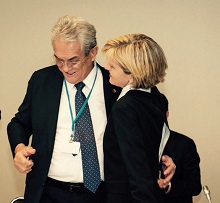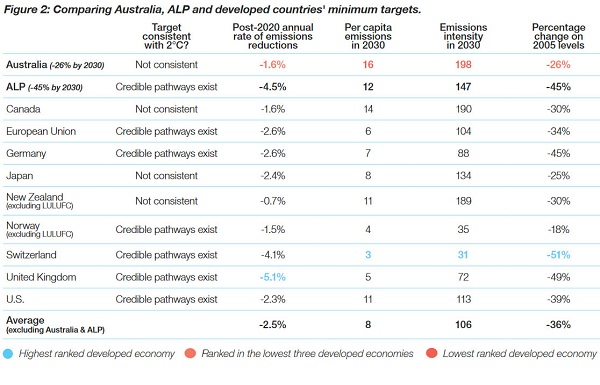 In spite of information that Turnbull had done a deal on climate with the denialist Nationals in return for their support of the Coalition, hopes lived on that the Government would begin to take climate change seriously. At the Paris conference last December Greg Hunt, says Bill McKibben, went “on and on about his great, deep personal commitment to all of this, and how this was his most pressing personal thing you could ever imagine” and Julie Bishop more than entered into the spirit of things. The photo shows her close and friendly with Tony de Brum of the Marshall Islands.
In spite of information that Turnbull had done a deal on climate with the denialist Nationals in return for their support of the Coalition, hopes lived on that the Government would begin to take climate change seriously. At the Paris conference last December Greg Hunt, says Bill McKibben, went “on and on about his great, deep personal commitment to all of this, and how this was his most pressing personal thing you could ever imagine” and Julie Bishop more than entered into the spirit of things. The photo shows her close and friendly with Tony de Brum of the Marshall Islands.
Tony de Brum, foreign minister of the Marshall Islands, was one of the leading lights of the “High Ambition Coalition” which had been formed six months earlier and had a massive influence on the final agreement. They broke cover towards the end of Paris.
Bishop, responding to negative tweets, moved to have Australia belatedly join the Coalition. de Brum said anyone can join, but bring your credentials with you.
The Coalition appears to have been initiated by the EU; certainly it began with a meeting chaired by the EU and Norway on 17 May 2015 in Berlin with representatives from Angola, Marshall Islands, Germany, Grenada, Peru, Santa Lucia, UK, Gambia, Colombia, Chili, Mexico and Switzerland.
Going into Paris the Coalition had about 90 members, including the US which had just joined. Now it includes heavy-hitters such as the US, Canada, Germany and Brazil and over 100 countries in all who are mutually seen to be serious about climate change mitigation.
The Coalition is continuing to meet, but Australia, when attending the official signing of the Paris Agreement in April, was not invited, in an obvious snub along with Japan, a fellow recalcitrant.
Oor Government cannot hide in world opinion. For all its spruiking our reputation has not improved under Turnbull, in fact it may have deteriorated.
Giles Parkinson has a long analysis on the mixed signals coming from the Government. They talk wind and solar up, and at the same time they talk them down.
Hunt claimed credit for 1,100MW of new renewable energy projects that he said would help meet the 6,000MW of new capacity required to meet the pared down renewable energy target for 2020. Unfortunately for his credibility half the capacity is being built for the ACT under its reverse auction scheme. These projects do not count towards the RET, as the ACT didn’t want to build capacity so that other states could do less.
Furthermore some projects have received grant funding from the Australian Renewable Energy Agency (ARENA), which Turnbull’s mob have gutted and defunded.
And there are lies about the impact of renewables on electricity prices. In SA, for example, renewables have tended to lower the price, the problem is the booming price of gas.
Labor’s climate policy is high on ambition but only allocates $206.6 million to ARENA “to support a specific Concentrated Solar Thermal funding round”. It doesn’t sound like much. ARENA says
- the Coalition decision to remove its grant-funding ability, saying it will make it harder to bridge the “valley of death” for new technologies.
So it’s not clear how either major party will crank up the renewables industry. The LNP is waiting to hear what the Climate Change Authority will recommend it does to implement the Paris Agreement, with its report conveniently due at the end of June.
Mark Butler at the Press Club was aiming big:
- Labor’s plans will position Australia again as a renewable energy superpower. We will ensure that at least 50 per cent of the nation’s electricity is renewable by 2030 – an ambitious but an achievable target.
And a targeted grant round will finally give concentrated solar thermal power, solar power with storage, a foot-hold in Australia.
Labor’s review of the national electricity market rules will bring the system into the 21st century – reflecting trends like distributed generation and storage – as well as the imperative to decarbonise one of the world’s most emissions intensive electricity sectors.
I’ve highlighted the phrases that contrast ambition with reality.
Labor’s central commitment to cleaner power is an electricity emissions trading scheme and a plan for a plan. It will:
- Develop a long-term plan to ensure the orderly transition of Australia’s energy generation from polluting coal-fired power stations to renewable and clean energy, with a core focus on supporting workers and communities.
In a refreshing change we had this recently from Anthony Patt, professor at the ETH in Zurich:
- There are also countless articles suggesting that the one key policy instrument that we need to solve the problem is a carbon tax or cap-and-trade market. We know, from two decades of social-science research, that these instruments do work to bring about marginal reductions in emissions, largely by stimulating improvements in efficiency. We also know that, at least so far, they have done virtually nothing to stimulate investment in the more sweeping changes in energy infrastructure that are needed to eliminate reliance on fossil fuels as the backbone of our system, and hence reduce emissions by 100%.
In the context of achieving 100% reductions in a relevant time, ETS schemes are simply inadequate, and are increasingly seen as such.
Labor has been making some noises recently about community power hubs to help pensioners and renters and other ideas.
Whether what Labor proposes amounts to a coherent approach or not, Turnbull and company are worried by anything that looks as though it might work. As Giles Parkinson said back on 2 May, they went straight into Abbott-style scare campaign mode when Labor’s policies were announced:
- Within 24 hours, almost the entire Coalition cabinet had managed to trot out the Abbott-era slogan of a “great big electricity tax”, and launched an attack ad against leader Bill Shorten on YouTube.
In the same week that the Coalition had trumpeted a $50 billion spend on French submarines as “economy building,” it attacked Labor’s $48 billion spend on renewables as jobs-destroying. Defence jobs good, green jobs bad.
The themes pedalled by the Coalition and the mainstream media were so similar, they could have been orchestrated: Renewables are too costly, cutting emissions will destroy the economy, Australia is leading the rest of the world, and what Australia does in any case won’t matter because it accounts for less than 2 per cent of global emissions.
Hunt keeps saying that we will “meet and beat” our targets, but stories keep appearing like Two-thirds of Australia’s emissions fund spent for just 7% of 2030 target and Direct Action funds ‘spent on projects that would have happened anyway’. A Fairfax poll found that two-thirds of voters say the Turnbull government is doing “not very much” or “nothing at all” to combat climate change.
The Climate Institute has compared the Australian government’s emissions targets for 2030 with those of the ALP and other OECD countries:

Sorry about the legibility, but the message is that the Government has us at the back of the pack, with targets that are not consistent with a 2°C temperature rise. Labor has us in the game.
That is, in terms of their intentions. You may recall that John D was not impressed.
So it’s a choice between a party with good intentions and a plan for a plan, and one that appears, quite frankly, to be playing a double game of keeping up appearances while doing nothing to disturb the dreams of the fossil fuel merchants.
In April The Climate Institute released a report A Switch in Time: Enabling the electricity sector’s transition to net zero emissions. Key points of their ‘Clean in, Carbon out’ scenario are as follows:
-
+ clean energy capacity grows by 2,500 MW per year
over the same period, or 2.5 times the amount
driven by the Weak Start Carbon Price;
+ retirement of coal generators is spread out over
time to average 1,500 MW annually to 2035;
+ the reliance of clean energy investments on a
subsidy declines from about 50 per cent of their
revenue to barely 4 per cent by 2030;
+ halving of the emissions gap between the 2°C
Carbon Price and the Weak Start Carbon Price
scenarios; and
+ requirement for 290 million tonnes of offsets to
achieve the carbon budget.
Both parties may care to take a look.

It amazes me that federal and state governments are ignoring the outstanding success of the ACT renewable auction scheme. We should also be looking at introducing auction based schemes for setting rooftop solar FIT’s.
Good to see at long last people are starting to realize that emissions trading and carbon taxes are costly duds. The Greens and Labor should be taking notice of this.
Neither the LNP or Labor seem to be strongly committed to reducing emissions at the rate needed to save the planet.
Part of Labor’s policy is to set an example and use green energy for the Commonwealth’s own purposes. I’m not sure how much that would amount to outside the ACT. I imagine not much. There is talk of them using reverse auctions to do it.
I have a puzzlement over two seemingly conflicting articles on renewables that appeared in RenewEnergy recently. I’ll do a separate post.
Chile?